North Dakota’s oil and coal development has shown little impact on air quality

By Rob Port | Watchdog.org North Dakota Bureau
CLEAN POWER: The American Lung Association gave North Dakota top marks for air quality, including in six counties that represent the heart of oil and coal production in the state.
BISMARCK, N.D. — The Environmental Protection Agency has announced emissions rules for power plants President Obama says are needed to protect the health of Americans.
But in North Dakota, where the rapid pace of oil development exists alongside what industry sources say is an 800-year supply of lignite coal, that argument doesn’t seem to match the facts on the ground.
The proposed EPA rules announced Monday would require power plants to cut emissions by 30 percent by 2030. They would be implemented in 2016 after a one-year public commenting period.
“We don’t have to choose between the health of our economy and the health of our children,” Obama said of the rules in his weekly address released Saturday. “As president and as a parent, I refuse to condemn our children to a planet that’s beyond fixing.”
But in North Dakota, fossil fuel energy development seems to have had little impact on air quality. According to the American Lung Association’s 2014 State of the Air report, the state gets a top grade for air quality specifically in counties with intense fossil fuel energy development.
Every county in the state measured by the ALA got an “A” grade, including Billings, Burke, Dunn and McKenzie counties where oil production and natural gas flaring have made national headlines. Two more counties, Mercer and Oliver, are home to five coal-fired power plants.
The coal industry in North Dakota warns that new EPA regulations could hurt the state’s economy and the power grid.
“Demand for electrical power in North Dakota is expected to increase by 208 percent over the next 20 years,” said Jason Bohrer, president of the Lignite Energy Council. “Our lignite coal reserves provide approximately 80 percent of the power within North Dakota, as well as 2 million people throughout the Upper Midwest. Any regulations that would require unfeasible retrofits to continue operation of existing plants would greatly impact power reliability and our economy. Unreasonable regulations could lead to layoffs, higher unemployment, increased costs to consumers and depressed economic activity.”
North Dakota Public Service Commissioner Randy Christmann told Watchdog previously these new rules were restricting the development of new power plants even before they were announced.
“Nothing is in the planning stages for new coal plants,” Christmann said in January, suggesting the EPA is “threatening” the state’s power grid.
You can reach Rob Port at rport@watchdog.org







